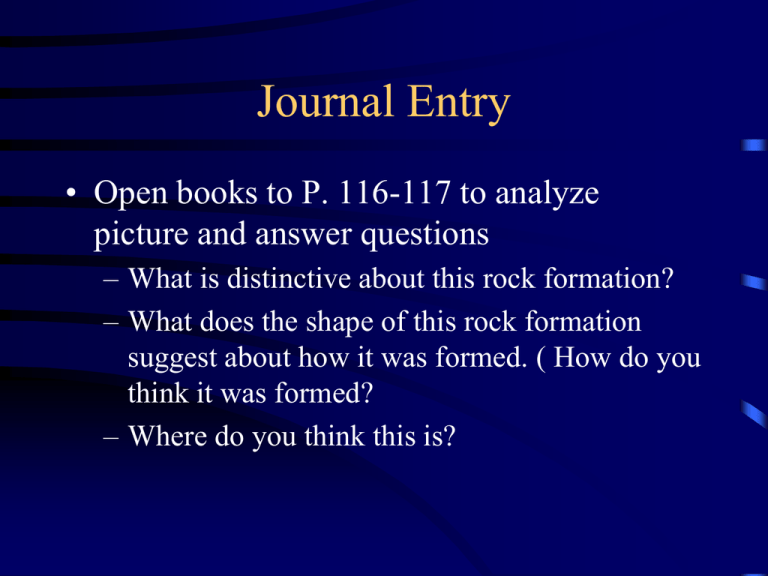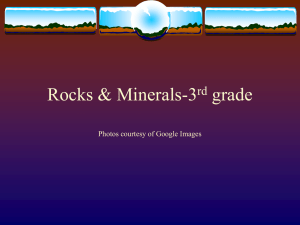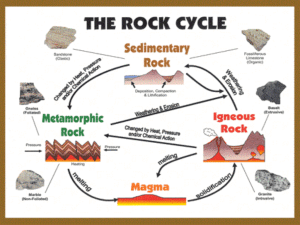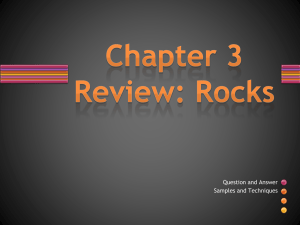Rocks PPT
advertisement

Journal Entry • Open books to P. 116-117 to analyze picture and answer questions – What is distinctive about this rock formation? – What does the shape of this rock formation suggest about how it was formed. ( How do you think it was formed? – Where do you think this is? Rocks • What is a rock? – Rocks and Minerals are often confused. It is important to understand the difference. – A rock is: ________________________ 3 types • Igneous- from cooling magma inside earth or cooling lava on surface of earth • Sedimentary- made of broken up bits of rocks (called sediment) which is eventually cemented together • Metamorphic- deformed rock Rock cycle Shows the interrelationships among the three rock types Earth as a system: the rock cycle • Magma • Crystallization • Igneous rock • Weathering, transportation, and deposition Rock cycle Earth as a system: the rock cycle • Full cycle does not always take place due to "shortcuts" or interruptions • • • • e.g., Sedimentary rock melts e.g., Igneous rock is metamorphosed e.g., Sedimentary rock is weathered e.g., Metamorphic rock weathers Rock cycle Earth as a system: the rock cycle • Sediment • Lithification • Sedimentary rock • Metamorphism • Metamorphic rock • Melting • Magma The rock cycle Magma • Crystallization- What is it? • Cooling magma creates Igneous rocks Check up Quiz • Can an igneous rock become another igneous rock? • How are the processes involved with the formation of Igneous and metamorphic rocks different? • Is there a beginning or end to this cycle? Igneous Rock Igneous rock exposed at earth’s surface is weathered, transported and deposited at a new location as sediment Sediment Lithification • Sediment- What is it? • Lithification- Sediment hardening creates Sedimentary rocks. Lithification Sedimentary Rock • As Sediment continues to be deposited and as layers become thicker the rock becomes deformed • Metamorphism- Solid state changes in sedimentary or igneous rocks. • Metamorphism of rock creates new class of rock called…. Metamorphic Rock • As pressure and temperature increase, for various reasons (Subduction, Volcanism, Lithification), a rock may begin to melt • Recreates Magma Magma • Melting occurs and the whole process starts over. Link: **Rock Cycle Movie- (5 mins)** **Rock Cycle Animation** Igneous rocks Form as magma cools and crystallizes • Rocks formed inside Earth are called plutonic or intrusive rocks • Rocks formed on the surface • Formed from lava (a material similar to magma, but without gas • Called volcanic or extrusive rocks Igneous rocks Crystallization of magma • Ions are arranged into orderly patterns • Crystal size is determined by the rate of cooling • Slow rate forms large crystals • Fast rate forms microscopic crystals • Very fast rate forms glass Magma Crystallization Link: Crystal Growth • Rock Formation animation Igneous rocks Classification is based on the rock's texture and mineral constituents • Texture • Size and arrangement of crystals • Types • Fine-grained – fast rate of cooling • Coarse-grained – slow rate of cooling • Porphyritic (two crystal sizes) – two rates of cooling • Glassy – very fast rate of cooling Fine-grained igneous texture Course-grained igneous texture Porphyritic igneous texture Obsidian exhibits a glassy texture Igneous rocks Classification is based on the rock's texture and mineral constituents • Mineral composition • Explained by Bowen's reaction series which shows the order of mineral crystallization • Influenced by crystal settling in the magma Igneous rocks Naming igneous rocks • Granitic rocks • Composed almost entirely of light-colored silicates quartz and feldspar • Also referred to as felsic: feldspar and silica (quartz) • High silica content (about 70 percent) • Common rock is granite Granite Igneous rocks Naming igneous rocks • Basaltic rocks • Contain substantial dark silicate minerals and calcium-rich plagioclase feldspar • Also referred to as mafic: magnesium and ferrum (iron) • Common rock is basalt Basalt Igneous rocks Naming igneous rocks • Other compositional groups • Andesitic (or intermediate) • Ultramafic Classification of igneous rocks Rock Quiz • Explain the Rock Cycle in your own words. Feel free to use an illustration • What are PIN’s? List 2 characteristics • What are VEX’s? List 2 characteristics • Explain how rocks get their textures. Sedimentary rocks Form from sediment (weathered products) About 75% of all rock outcrops on the continents Used to reconstruct much of Earth's history • Clues to past environments • Provide information about sediment transport • Rocks often contain fossils Sedimentary rocks Sedimentary rocks are produced through lithification • Loose sediments are transformed into solid rock • Lithification processes • Compaction • Cementation by • Calcite • Silica • Iron Oxide Sedimentary rocks Features of sedimentary rocks • Strata, or beds (most characteristic) • Bedding planes separate strata • Fossils • • • • • Traces or remains of prehistoric life Are the most important inclusions Help determine past environments Used as time indicators Used for matching rocks from different places Sedimentary rocks Economic importance • Coal • Petroleum and natural gas • Sources of iron and aluminum Sedimentary rocks Classifying sedimentary rocks • Three groups based on the source of the material • Detrital rocks (CLASTIC) • Chemical • Organic Detrital/Clastic Sed. Rocks • Material is solid particles • Classified by particle size • Boulder, Gravel, Pebbles, Sand, Clay…. • Common rocks include • Shale (most abundant) • Sandstone • Conglomerate Classification of sedimentary rocks Shale with plant fossils Sandstone Conglomerate Chemical Sedimentary rocks • Many of these form when standing water evaporates, leaving dissolved minerals behind. • Unlike most other sedimentary rocks, chemical rocks are not made of pieces of sediment. Instead, they have mineral crystals made from elements that are dissolved in water. Chemical Sedimentary rocks • Chemical rocks • Common sedimentary rocks • Limestone – the most abundant chemical rock • Microcrystalline quartz (precipitated quartz) known as chert, flint, jasper, or agate • Evaporites such as rock salt or gypsum • Coal Formation • 1) Water becomes supersaturated • 2) Water dissolves which leaves less room for dissolved minerals • 3) Crystals begin to form, like halite• Example: Salt Lake, UT • 4) Large crystal deposits Fossiliferous limestone Rock salt Limestone Caves Rock Salt @ Great Salt Lake, UT Organic Sedimentary Rocks • Made of dead plants and animals that are cemented together. • The hard parts of animals, such as bones and shells, can become cemented together over time to make rock. Bituminous Coal Coquina Metamorphic rocks "Changed form" rocks Produced from preexisting • Igneous rocks • Sedimentary rocks • Other metamorphic rocks Metamorphic rocks Metamorphism • Takes place where preexisting rock is subjected to temperatures and pressures unlike those in which it formed • Degrees of metamorphism • Exhibited by rock texture and mineralogy • Low-grade (e.g., shale becomes slate) • High-grade (obliteration of original features) Metamorphic rocks Metamorphic settings • Contact, or thermal, metamorphism • Occurs near a body of magma • Changes are driven by a rise in temperature • Regional metamorphism • Directed pressures and high temperatures during mountain building • Produces the greatest volume of metamorphic rock Metamorphic rocks Metamorphic agents • Heat • Pressure (stress) • From burial (confining pressure) • From differential stress during mountain building • Chemically active fluids • Mainly water and other volatiles • Promote recrystallization by enhancing ion migration Origin of pressure in metamorphism Metamorphic rocks Metamorphic textures • Foliated texture • Minerals are in a parallel alignment • Minerals are perpendicular to the compressional force • Nonfoliated texture • Contain equidimensional crystals • Resembles a coarse-grained igneous rock Development of foliation due to directed pressure Metamorphic rocks Common metamorphic rocks • Foliated rocks • Slate • Fine-grained • Splits easily • Schist • Strongly foliated • "Platy" • Types based on composition (e.g., mica schist) Classification of metamorphic rocks Metamorphic rocks Common metamorphic rocks • Foliated rocks • Gneiss • Strong segregation of silicate minerals • "Banded" texture • Nonfoliated rocks • Marble • Parent rock is limestone • Large, interlocking calcite crystals Gneiss typically displays a banded appearance Metamorphic rocks Common metamorphic rocks • Nonfoliated rocks • Marble • Used as a building stone • Variety of colors • Quartzite • Parent rock – quartz sandstone • Quartz grains are fused Marble – a nonfoliated metamorphic rock Resources from rocks and minerals Metallic mineral resources • Gold, silver, copper, mercury, lead, etc. • Concentrations of desirable materials are produced by • Igneous processes • Metamorphic processes Resources from rocks and minerals Metallic mineral resources • Most important ore deposits are generated from hydrothermal (hot-water) solutions • • • • Hot Contain metal-rich fluids Associated with cooling magma bodies Types of deposits include • Vein deposits in fractures or bedding planes, and • Disseminated deposits which are distributed throughout the rock Resources from rocks and minerals Nonmetallic mineral resources • Make use of the material’s • Nonmetallic elements • Physical or chemical properties • Two broad groups • Building materials (e.g., limestone, gypsum) • Industrial minerals (e.g., fluorite, corundum, sylvite) End of Chapter 2









